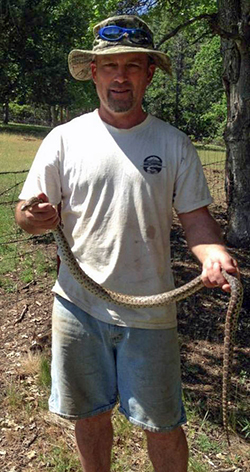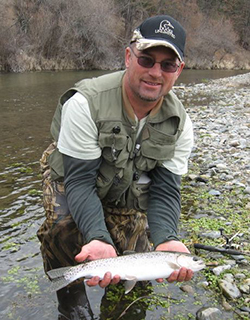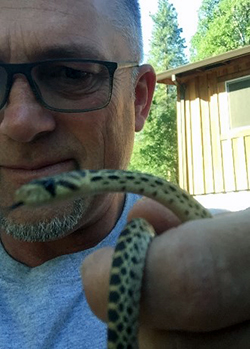


Joe Croteau is an environmental program manager with the Timberland Conservation Program in CDFW’s Northern Region. He oversees a team of scientists and administrators responsible for conservation and regulatory compliance on approximately 5 million acres of non-federal timber production lands in the Northern Region. The team includes dedicated people working in Fort Bragg, Eureka, Yreka and Redding. Joe’s office is in Redding, but his job takes him to all corners of the region, occasionally headquarters in Sacramento, and to the hidden forests in between.
An avid outdoorsman, Joe has been a member of The Wildlife Society, The Rocky Mountain Elk Foundation, The Wild Turkey Federation and the California Licensed Foresters Association. He served as President of a local unit of the Backcountry Horseman’s Association and is a Hunter Education Instructor.
Who or what inspired you to become a scientist?
The “who” is my mother. She made sure I could go fishing, play in the poison oak and bring home lizards and snakes … and she took me to the doctor’s office when I was reckless. She turned me on to Wild Kingdom where I latched on to Marlin Perkins’ conservation movement. I immediately connected with Marlin and his friend Jim Fowler as they explored all critters, both safe and dangerous.
The “what” is just an innate curiosity and admiration of fish and wildlife … and my mom informing me I could actually earn a degree and have a career doing this kind of stuff.
How did you come to work for CDFW?
I earned a Bachelor’s degree in Wildlife Management from Humboldt State University in 1990, and came to CDFW’s toxicology laboratory in Elk Grove in 1991 as a scientific aid. The Cantara spill happened in July 1991 and so I participated in the evaluation of that ecological disaster. A train car fell into the Upper Sacramento River spilling about 19,000 gallons of the herbicide metam sodium. I was part of a team that was responsible for evaluating the damages and measuring lethal doses to aquatic species. After bouncing around a bit, I finally landed in in the Timberland Conservation Program.
You’ve been with the Timberland Conservation Program since 2001. What is the purpose of the program, and why is it important?
The California Forest Practice rules require an entity that wants to harvest timber on non-federal lands to first file a timber harvesting document. CDFW is the trustee agency that reviews and provides recommendations for the proposed harvesting plan. Our top priority is to ensure the conservation of fish, wildlife, and plants on land where timber harvesting is going to occur. We think of ourselves as a Swiss army knife and can tackle just about any conservation challenge.
What is a typical day like for you at work?
Personally, my typical day includes correspondence or a meeting to make sure our team has the funding, tools and inspiration to do their jobs. The better story is a typical day in the Timberland Conservation Program. Today, one of our staff members is probably walking in the woods with a forester to look at a timber harvesting plan, a proposed bridge and a meadow restoration project. A couple others are administering grants for Yreka Phlox and Townsend’s big-eared bats. Two or three others are working through the challenges of developing safe harbor agreements for Humboldt Martens, Great Gray Owls, Gray Wolves and Coho Salmon. Somebody is probably at their computer looking at multiple monitors to model wildlife habitat or a decision support tool. Somebody is thinking about how to incorporate drones and bio-dogs into our workplace. Somebody is working on regulatory rules to conserve sensitive plants. Several are involved with various working groups like the one dealing with barred owl impacts to northern spotted owls, or doing strategic planning. Certainly, somebody is preparing for, attending, or summarizing a meeting. The supervisors are looking forward, motivating and enabling their staff to challenge the system.
Every one of them is thinking about how best to monitor the effectiveness of everything we do. Oh, and there is the whole email thing … we call it “whack a mole.”
What is the most rewarding project that you’ve worked on for CDFW?
I would go back to the Great Gray Owl project that I was encouraged to tackle by my manager in 2008. The Great Gray Owl is a state endangered species we knew very little about. At the time, we were aware of breeding pairs in Yosemite and in Southern Oregon, but we weren’t sure if there were any in our region. I pursued a state wildlife grant that enabled us to look for breeding pairs, and nine different private and federal landowners allowed us to conduct surveys on their properties. We found two reproducing pairs during the study and have identified a couple more since. I remember getting a text message around midnight from a scientific aid in the first month of the study. It said, “If or when you wake up, call me. Male GGO!” That was an awesome moment.
Websites, conservation strategies and textbooks were later modified based on that work. Scientific aids from that project went on to become environmental scientists. Safe harbor agreements are being crafted because of our study. That’s the personal project that makes me proudest.
If you had free reign and unlimited funding, what scientific project would you most like to do today?
Wow, fun. I would like to create a fire-resilient landscape that enhances deer, elk, pronghorn and sage grouse carrying capacity. I would probably eliminate all but the few oldest junipers from the landscape, and I would work with our internal and external experts to return our cheatgrass-infested basins to support low sage and bitter brush habitat. I would try to bring our mountain meadows back to life by removing suppressed conifers and restoring hydrologic connectivity. I would then hire enough people to investigate and brag about all the good we are doing.
What is it about the work you do that you find most interesting or rewarding?
I often miss getting on the ATV, chasing down an owl or a fish, and just getting dirt on my clothes. But – and this is somewhat surprising to me – the best part of my job is probably not handling a fish, bird or plant. What I really enjoy is recruiting people to our team, helping somebody else prepare for an interview, and seeing people promote and move on to bigger challenges. Allowing people to seek training, explore new information technology and feeling safe to challenge the system is enormously rewarding.
I am most grateful to be associated with a team and a department loaded with hardworking, intelligent and dedicated people. This is what I brag about to family and friends.
What is the most challenging part of your job?
Remembering to strive to be an inspirational leader so that staff can embrace our most difficult challenges. Reminding myself what I represent, who I represent, and thinking forward with a vision … the ability to do that is not something anybody is born with. Those are learned behaviors, and it’s always a work in progress for me.
Do you have any advice for people considering careers in science or natural resources?
Be persistent, and know that it is not for material gain that any of us do this. You need to be willing to move around a bit, embrace uncomfortable challenges, and strive to become really good at what you do.